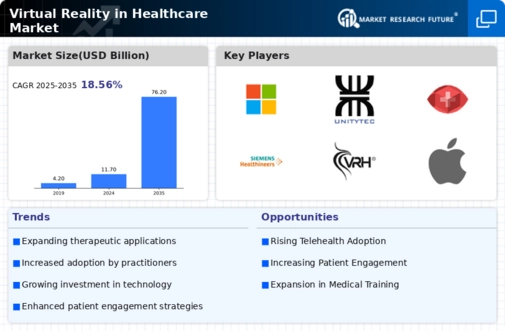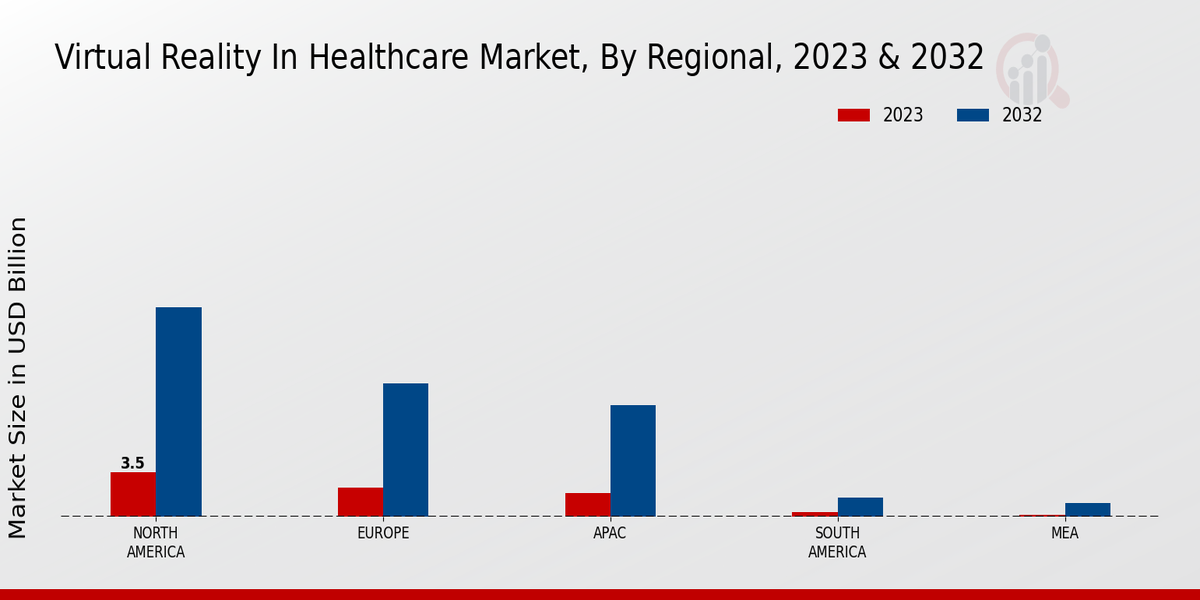Market Growth Projections
The Global Virtual Reality in Healthcare Market Industry is projected to experience substantial growth over the next decade. With an estimated market value of 11.7 USD Billion in 2024, it is expected to escalate to 76.2 USD Billion by 2035. This growth trajectory suggests a compound annual growth rate (CAGR) of 18.61% from 2025 to 2035. Such projections highlight the increasing integration of VR technologies across various healthcare applications, including pain management, mental health treatment, and medical training. The anticipated expansion underscores the potential of VR to revolutionize healthcare delivery and improve patient outcomes.
Advancements in VR Technology
Technological advancements play a pivotal role in shaping the Global Virtual Reality in Healthcare Market Industry. Innovations in hardware and software are enhancing the quality and accessibility of VR applications in healthcare. For instance, the development of more affordable VR headsets and user-friendly software platforms is making it easier for healthcare providers to implement VR solutions. These advancements not only improve the efficacy of VR applications but also broaden their applicability across various medical fields, including rehabilitation and surgical training. As these technologies continue to evolve, the market is likely to witness accelerated growth, contributing to a projected CAGR of 18.61% from 2025 to 2035.
Growing Focus on Mental Health Treatment
The Global Virtual Reality in Healthcare Market Industry is increasingly focusing on mental health treatment, as VR applications are being developed to address conditions such as anxiety, PTSD, and phobias. Immersive VR environments allow patients to confront and manage their fears in a controlled setting, which can lead to significant therapeutic benefits. The rising awareness of mental health issues and the need for innovative treatment modalities are driving this trend. As mental health becomes a priority in healthcare systems worldwide, the integration of VR into therapeutic practices is expected to expand, further propelling market growth.
Increasing Adoption of Telehealth Solutions
The Global Virtual Reality in Healthcare Market Industry is experiencing a notable surge in the adoption of telehealth solutions. As healthcare providers increasingly integrate virtual reality into remote consultations and patient monitoring, the market is projected to reach 11.7 USD Billion in 2024. This trend is driven by the need for accessible healthcare services, especially in underserved areas. Virtual reality facilitates immersive experiences that enhance patient engagement and education, potentially improving health outcomes. The growing acceptance of telehealth among patients and providers alike indicates a shift towards more innovative healthcare delivery models, thereby expanding the market's reach.
Rising Demand for Pain Management Solutions
Pain management remains a critical area within the Global Virtual Reality in Healthcare Market Industry. Virtual reality applications are increasingly utilized to alleviate pain through immersive distraction techniques. Studies suggest that VR can reduce pain perception during medical procedures, leading to enhanced patient comfort. As the healthcare industry seeks effective alternatives to opioid prescriptions, VR presents a promising solution. The anticipated growth of the market to 76.2 USD Billion by 2035 reflects the increasing recognition of VR's potential in pain management, which could significantly reshape treatment protocols and patient experiences.
Enhanced Training and Education for Healthcare Professionals
The Global Virtual Reality in Healthcare Market Industry is witnessing a transformation in the training and education of healthcare professionals. VR simulations provide immersive learning experiences that allow medical students and practitioners to practice procedures in a risk-free environment. This hands-on approach enhances skill acquisition and retention, ultimately improving patient care. As healthcare education increasingly incorporates VR technology, the demand for such solutions is likely to rise. This trend not only benefits the training of new professionals but also supports ongoing education for existing practitioners, thereby fostering a more competent healthcare workforce.















